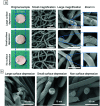Influence of surface topography on PCL electrospun scaffolds for liver tissue engineering
- PMID: 34491259
- PMCID: PMC8493469
- DOI: 10.1039/d1tb00789k
Influence of surface topography on PCL electrospun scaffolds for liver tissue engineering
Abstract
Severe liver disease is one of the most common causes of death globally. Currently, whole organ transplantation is the only therapeutic method for end-stage liver disease treatment, however, the need for donor organs far outweighs demand. Recently liver tissue engineering is starting to show promise for alleviating part of this problem. Electrospinning is a well-known method to fabricate a nanofibre scaffold which mimics the natural extracellular matrix that can support cell growth. This study aims to investigate liver cell responses to topographical features on electrospun fibres. Scaffolds with large surface depression (2 μm) (LSD), small surface depression (0.37 μm) (SSD), and no surface depression (NSD) were fabricated by using a solvent-nonsolvent system. A liver cell line (HepG2) was seeded onto the scaffolds for up to 14 days. The SSD group exhibited higher levels of cell viability and DNA content compared to the other groups. Additionally, the scaffolds promoted gene expression of albumin, with all cases having similar levels, while the cell growth rate was altered. Furthermore, the scaffold with depressions showed 0.8 MPa higher ultimate tensile strength compared to the other groups. These results suggest that small depressions might be preferred by HepG2 cells over smooth and large depression fibres and highlight the potential for tailoring liver cell responses.
Conflict of interest statement
There are no conflicts to declare.
Figures






Similar articles
-
A Drug-Induced Hybrid Electrospun Poly-Capro-Lactone: Cell-Derived Extracellular Matrix Scaffold for Liver Tissue Engineering.Tissue Eng Part A. 2017 Jul;23(13-14):650-662. doi: 10.1089/ten.TEA.2016.0419. Epub 2017 May 3. Tissue Eng Part A. 2017. PMID: 28437180
-
Electrospinning and evaluation of PHBV-based tissue engineering scaffolds with different fibre diameters, surface topography and compositions.J Biomater Sci Polym Ed. 2012;23(6):779-806. doi: 10.1163/092050611X560708. J Biomater Sci Polym Ed. 2012. PMID: 21418747
-
Combining human liver ECM with topographically featured electrospun scaffolds for engineering hepatic microenvironment.Sci Rep. 2024 Oct 5;14(1):23192. doi: 10.1038/s41598-024-73827-5. Sci Rep. 2024. PMID: 39369012 Free PMC article.
-
Co-culture cell-derived extracellular matrix loaded electrospun microfibrous scaffolds for bone tissue engineering.Mater Sci Eng C Mater Biol Appl. 2019 Jun;99:479-490. doi: 10.1016/j.msec.2019.01.127. Epub 2019 Jan 30. Mater Sci Eng C Mater Biol Appl. 2019. PMID: 30889723 Free PMC article.
-
Calendula officinalis extract/PCL/Zein/Gum arabic nanofibrous bio-composite scaffolds via suspension, two-nozzle and multilayer electrospinning for skin tissue engineering.Int J Biol Macromol. 2019 Aug 15;135:530-543. doi: 10.1016/j.ijbiomac.2019.05.204. Epub 2019 May 29. Int J Biol Macromol. 2019. PMID: 31152839
Cited by
-
Combination of melt-electrospun poly-ε-caprolactone scaffolds and hepatocyte-like cells from footprint-free hiPSCs to create 3D biohybrid constructs for liver tissue engineering.Sci Rep. 2023 Dec 13;13(1):22174. doi: 10.1038/s41598-023-49117-x. Sci Rep. 2023. PMID: 38092880 Free PMC article.
-
Modified five times simulated body fluid for efficient biomimetic mineralization.Heliyon. 2024 Jun 12;10(12):e32850. doi: 10.1016/j.heliyon.2024.e32850. eCollection 2024 Jun 30. Heliyon. 2024. PMID: 38975072 Free PMC article.
-
Fabrication of polycaprolactone electrospun fibres with retinyl acetate for antioxidant delivery in a ROS-mimicking environment.Front Bioeng Biotechnol. 2023 Aug 15;11:1233801. doi: 10.3389/fbioe.2023.1233801. eCollection 2023. Front Bioeng Biotechnol. 2023. PMID: 37650040 Free PMC article.
-
Recent Methods for Modifying Mechanical Properties of Tissue-Engineered Scaffolds for Clinical Applications.Biomimetics (Basel). 2023 May 16;8(2):205. doi: 10.3390/biomimetics8020205. Biomimetics (Basel). 2023. PMID: 37218791 Free PMC article. Review.
-
In vitro modeling of hepatocellular carcinoma niche on decellularized tomato thorny leaves: a novel natural three-dimensional (3D) scaffold for liver cancer therapeutics.Front Bioeng Biotechnol. 2023 May 5;11:1189726. doi: 10.3389/fbioe.2023.1189726. eCollection 2023. Front Bioeng Biotechnol. 2023. PMID: 37251569 Free PMC article.
References
-
- British Liver Trust, The alarming impact of liver disease in the UK, Bournemouth, 2019
-
- Williams R. Alexander G. Armstrong I. Baker A. Bhala N. Camps-walsh G. Cramp M. E. De Lusignan S. Day N. Dhawan A. Dillon J. Drummond C. Dyson J. Foster G. Gimore I. Hudson M. Kelly D. Langford A. McDougall N. Meier P. Moriarty K. Newsome P. O’Grady J. Pryke R. Rolfe L. Rice P. Rutter H. Sheron N. Taylor A. Thompson J. Thorburn D. Verne J. Wass J. Yeoman A. Disease burden and costs from excess alcohol consumption, obesity, and viral hepatitis: fourth report of the Lancet Standing Commission on Liver Disease in the UK. Lancet. 2018;391(10125):1097–1107. doi: 10.1016/S0140-6736(17)32866-0. doi: 10.1016/S0140-6736(17)32866-0. - DOI - DOI - PubMed
-
- Grant R. Hay D. Callanan A. From scaffold to structure: the synthetic production of cell derived extracellular matrix for liver tissue engineering From scaffold to structure: the synthetic production of cell derived extracellular matrix for liver tissue engineering. Biomed. Phys. Eng. Express. 2018;4(6):65015. doi: 10.1088/2057-1976/aacbe1. doi: 10.1088/2057-1976/aacbe1. - DOI - DOI
Publication types
MeSH terms
Substances
Grants and funding
LinkOut - more resources
Full Text Sources

